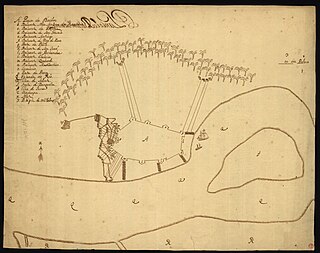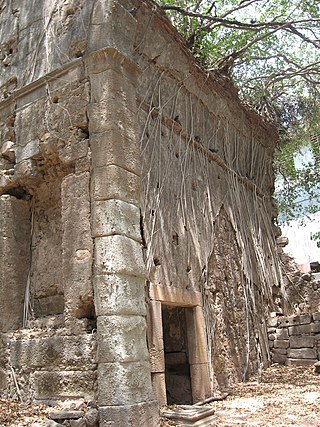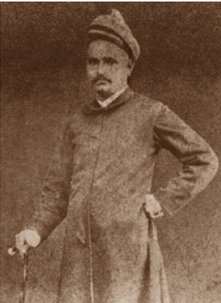
Goregaon ([ɡoːɾeɡaːʋ]) is a suburb of Mumbai city, in the Mumbai Suburban district of India. It has a railway station on the Mumbai suburban railway on the Western Line. An extension of the Harbour Line was completed in 2018 because of which it has regular trains to CSMT on the Harbour line. This is in addition to existing trains to Churchgate on the Western Line. Owing to the rapid urbanization and growing population of metropolitan Mumbai, Goregaon, which was once merely a hilly forest region is now a crowded suburb of Mumbai.

Salsette Island is an island in Konkan division of the state of Maharashtra, along India's west coast. Administratively known as Greater Mumbai, the Mumbai Suburban district, Mira Bhayander and a portion of Thane district lie within it, making it very populous and one of the most densely populated islands in the world. It has a population of more than 20 million inhabitants living on an area of about 619 square kilometres (239 sq mi).

Vasai is a historical place and city located in Palghar district; which was partitioned out of the Thana district in 2014. It also forms a part of Vasai-Virar twin cities in the Konkan division, Maharashtra, India, and comes under the Police Jurisdiction of Mira-Bhayander, Vasai-Virar Police Commissionerate.

Virar is a coastal city in Palghar district, Maharashtra. The northern third of the city of Vasai-Virar, it is administered by Vasai-Virar Municipal Corporation. It lies in the south part of Palghar district, and north to the city of Mumbai. It is an important part of Palghar District because Palghar is the outermost part of northern side of Mumbai Metropolitan Region and comes under Police Jurisdiction of Mira-Bhayander, Vasai-Virar Police Commissionerate.

Marve Beach is located in the Western Suburb of Malad in the city of Mumbai, India.

The East Indians, also called East Indian Catholics or Bombay East Indians, are an ethno-religious Indian Christian community native to the Seven Islands of Bombay and the neighbouring Mumbai Metropolitan Area of the Konkan division.

Fort Vasai is a ruined fort of the town of Vasai (Bassein), Konkan Division, Maharashtra, Indian Union. The structure was formally christened as the Fort of St Sebastian in the Indo-Portuguese era. The fort is a monument of national importance and is protected by the Archaeological Survey of India.

The Battle of Vasai or the Battle of Bassein was fought between the Marathas and the Portuguese rulers of Vasai, a town near Mumbai (Bombay) in the Konkan region of the present-day state of Maharashtra, India. The Marathas were led by Chimaji Appa, a brother of Peshwa Baji Rao I.
Norteiros were a historical people who lived in the former Portuguese exclaves in the western littoral parts of the northern Konkan region, in the present-day Greater Bombay Metropolitan Area and the federal territory of Damaon, Dio & Silvassa.

Manori is a village located on Dharavi Bet in northern Mumbai, India. It is known for its beach and the Manori Creek.

Chimaji Balaji Bhat, commonly referred to as Appa or Bhau, was the son of Balaji Vishwanath Bhat and the younger brother of Bajirao Peshwa of Maratha Empire. The high watermark of his career was the capture of Vasai fort from the Portuguese.

Samvedis or Samvedi Brahmins are an Indian Hindu Brahmin community, originating from a group of classical musicians and classical dancers. They follow Sama Veda and believed to have been originated from Odisha, India.

The Shree Vajreshwari Yogini Devi Mandir is a Hindu temple dedicated to the goddess Vajreshwari, located in the town Vajreshwari, 75 km away from Mumbai. The town, earlier known as Vadvali, was renamed Vajreshwari in honour of the presiding deity of the temple.

Bombay, also called Bom Bahia or Bom Baim in Indo-Portuguese creole, Mumbai in the local language; is the financial and commercial capital of India and one of the most populous cities in the world. It's also the cosmopolitan city centre of the Greater Bombay Metropolitan Area, and the cultural base of the Bollywood film industry. At the time of arrival of the Portuguese Armadas, Bombay was an archipelago of seven islands. Between the third century BCE and 1348, the islands came under the control of successive Hindu dynasties. The Delhi Sultanate had been ruling the area along with Chaul, New Bombay (Thana) & Damaon, with the administrative centre in Bassein (Vasai) since the raids of Malik Kafur in the Konkan region and across the Indian subcontinent. This territory in North Konkan along with the Bombay islands were later taken over by the Sultan of Guzerat from 1391 to 1534, when he had declared the end of the suzerainty to Delhi, after the Timurid invasion of it. Growing apprehensive of the power of the Moghal emperor Humayun, Sultan Bahadur Shah of Gujarat was obliged to sign the Treaty of Bassein on 23 December 1534; according to which, the seven islands of Bombay, Fort San Sebastian of Bassein in strategic town of Bassein (Vasai), and its dependencies were offered to the Portuguese East Indies. The places were only later officially surrendered on 25 October 1535, by the Sultan of Guzerat.
Vartak is an Indian surname found in the Konkan in Kelshi Maharashtra.

Shirgaon is a village in the Palghar district of the state of Maharashtra, India. It can be reached by State Transport busses or other public transportation from Palghar Station on the Mumbai - Ahmedabad train route. It has an extremely long beach with Kelva Beach on one side and Satpati on the other.
The Indo-Portuguese Creole of Bombay was a creole language based on Portuguese, which grew out of the long contact between the Portuguese and local languages such as Konkani, Marathi & Gujarati. Currently this language is extinct. It was spoken in Bombay (Mumbai), India: Which broadly includes Bassein (Vasai), Salsette, Taana (Trombay), Chevai, Mahim, Tecelaria, Dadar, Parel, Cavel, Bandora-Badra, Govai, Marol, Andheri, Versova, Malvan, Manori, Mazagaon. This language was, after the Ceylon creole dialect of Indo-Portuguese, the most important. In 1906 there were still close to 5,000 people who spoke Portuguese creole as their mother tongue, 2,000 in Mumbai and Mahim, 1000 in Bandora, 500 in Thana, 100 in Curla (Kurla), 50 in Bassein (Vasai) and 1,000 in other towns. There were, at that time, schools that taught the creole and the rich classes, which were replaced by the English language.

Sakharam Arjun was a physician and social activist in Bombay. An expert on Indian medicinal plants, he was one of the two Indian founding members of the Bombay Natural History Society. He became the step-father of the pioneering woman physician Rukhmabai (1864-1955) after he married her widowed mother Jayantibai. He also wrote books in Marathi.
Sakharam Hari Gupte was born in Chandraseniya Kayastha Prabhu (CKP) family, and was the commander and tipnis (secretary) of Peshwa Bajirao I. For few years he worked under Peshwa Nanasaheb and then became the General of Raghunathrao Peshwa. He was responsible for conquering Attock on the banks of the Indus and repelling the Durrani ruler, Ahmad Shah Abdali out of India in the 1750s.
The 'Prabhu caste' or Prabhu communities are a group of related Hindu castes belonging to the former ruling caste of statesmen, bureaucrats and aristocrats of Northern districts of Konkan region in Maharashtra, India. There are four such castes, all having different ritual and social status within the caste system of Maharashtra, but all of them having traditions traced back to the 12th century which label them as endogamous subdivisions of Kshatriyas of Solar and Lunar descent. They are Chandraseniya Kayastha Prabhu, Pathare Prabhu, Kanchole Prabhus and the Davane Prabhu.














